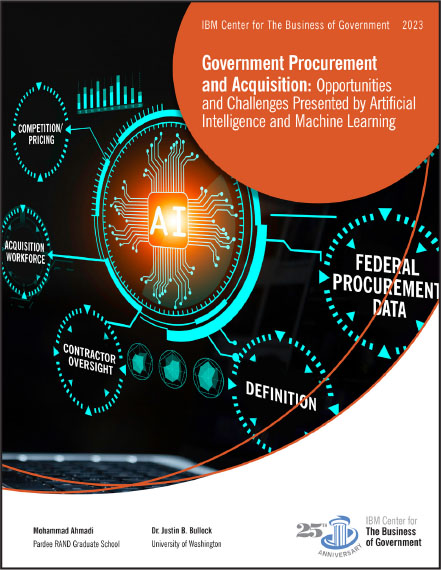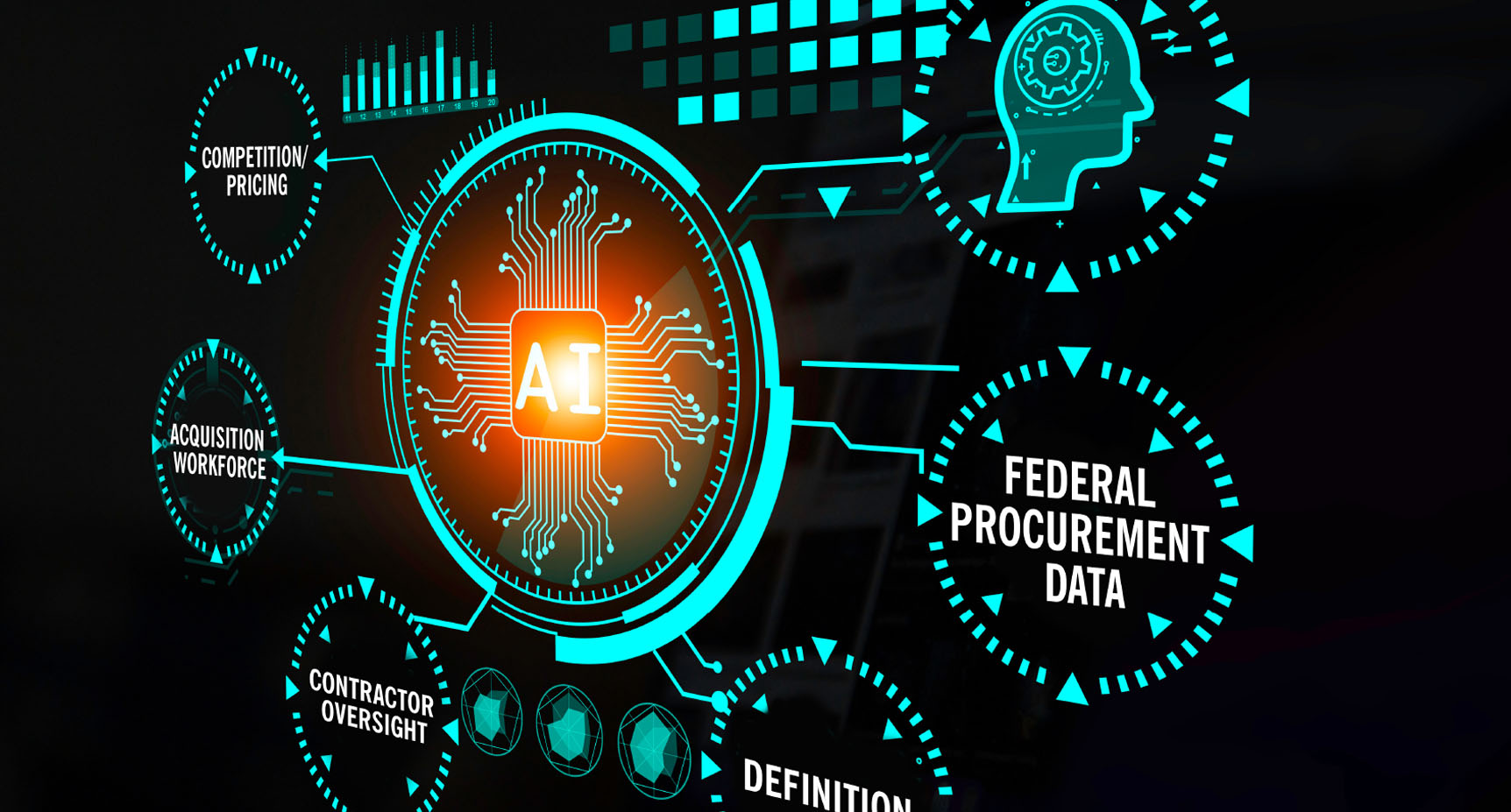
Government Procurement and Acquisition:
Opportunities and Challenges Presented by Artificial Intelligence and Machine Learning
Edited by Michael J. Keegan
The fourth contribution in this forum addresses using AI to transform public procurement, analyzing challenges and recommending ways to capitalize on opportunities. It makes recommendations about how to use AI to transform public procurement, which can increase speed, efficiency, and effectiveness in acquiring goods and services that serve public needs by fostering facilitating intelligent automation across the federal acquisition system.
What follows is an excerpt from the IBM Center report Government Procurement and Acquisition: Opportunities and Challenges Presented by Artificial Intelligence and Machine Learning by Mohammad Ahmadi and Dr. Justin B. Bullock, which recommendations about how to use AI to transform public procurement. This can increase speed, efficiency, and effectiveness in acquiring goods and services that serve public needs by fostering facilitating intelligent automation across the federal acquisition system.
Challenges Facing Modern Government Procurement
To serve the public, governments procure a wide variety of goods and services. The acquisition process lies at the heart of agencies’ abilities to provide goods and services in an effective, efficient, and equitable manner Given high agency investments—annual procurement spend exceeds $500 billion—and the complexity of government processes, procurement is an extremely challenging task to perform well. This impacts governments worldwide, and particularly large federal governments such as that of the United States.

Indeed, congressional panels and executive reports often highlight the challenges of procurement and acquisition, including prominent GAO reports addressed in this report in more detail. A 2018 GAO report in particular highlights a number of important challenges for improving federal procurement practice:
1. Requirements definition
2. Competition and pricing
3. Contractor oversight
4. Federal procurement data
5. Acquisition workforce
While these challenges do not represent the only hurdles facing procurement reform, they are challenges that AI and machine learning tools can help to address. AI applications can help improve effectiveness and efficiency across the U.S. federal procurement process. Recent studies in public administration and public management reflect a growing consensus that AI and ML tools, if carefully constructed and deployed, can help agencies complete certain types of tasks for governments. Opportunities exist for AI and ML tools to improve the functioning of procurement, but these opportunities will come with their own challenges that need to be carefully manage.
Connecting Procurement Challenges with AI Opportunities
This section highlights the AI use cases outlined in this report connecting them to a specific procurement related challenge facing U.S. federal government agencies.

Requirements definition challenge. Government procurement requires well-defined, achievable, and verifiable requirements to ensure successful contract outcomes. However, defining these requirements is often challenging due to workforce shortages, frequent turnover, and the complexity of the process, which can lead to vague or unrealistic specifications. This problem is evident in certain Department of Defense contracts, where unclear definitions have caused delays and increased costs, despite years of reforms aimed at improving procurement practices. Artificial intelligence offers promising tools to aid in specifying requirements.
AI Procurement Opportunity 1: Specification Definition. AI offers a valuable solution to improve specification accuracy. By analyzing data from past contracts, machine learning algorithms, such as recommender engines and ranking systems, can help procurement teams define requirements that are clearer, feasible, and verifiable. These tools assist by suggesting similar specifications from historical data, enabling more accurate predictions of required goods and services, especially for repeat procurements.
AI Use Case 1: Recommendation Algorithms. Additionally, deep learning models trained on historical data can help assess if specifications are realistic, providing agency staff with an added layer of verification. However, AI should complement rather than replace human expertise, enhancing efficiency in defining needs while relying on human judgment for final decisions. This approach aligns with the recommendation algorithms used by platforms like Amazon or Netflix, which effectively anticipate user preferences based on past behavior, and can similarly support procurement agents in aligning contract specifications with agency requirements.
Competition and pricing challenge. Federal procurement regulations mandate fair and reasonable pricing through competitive bidding, though agencies sometimes use sole-source contracts with only one supplier. Ensuring fair prices remains challenging, despite efforts like broadening competition, conducting market research, adopting private sector practices, and using interagency contracts. GAO reports little change in competitive versus non-competitive contract rates, with reasons including vendor preference, restrictive policies, and inadequate planning.
AI Procurement Opportunity 2: Improving Market Knowledge. AI offers promising solutions to support market research, acquisition planning, and price assessment. Machine learning can improve market knowledge by aiding acquisition teams in performing market research, planning acquisitions, and checking price fairness. For instance, virtual assistants powered by natural language processing (NLP) could search datasets and archives to provide answers and references for market questions, potentially saving time and resources. Deep learning can help identify patterns in acquisition planning issues, ensuring timely and cost-effective procurement.
AI Use Case 2: Natural Language Processing. NLP technologies, such as those in virtual assistants like Siri and Alexa, could be trained to assist with specific acquisition tasks, making market research faster and more efficient. Language models like ChatGPT can also summarize feedback, draft reports, answer complex questions, and conduct document searches. However, while AI tools offer efficiency, they should enhance human decision making rather than replace it, and ethical, privacy, and security concerns must be managed carefully as AI adoption grows in federal procurement.
Contractor oversight challenge. Contractor oversight ensures vendors deliver goods or services according to contract terms, but this process poses challenges. Uncertainty about the extent of oversight needed, combined with the technical expertise required to inspect deliveries, creates oversight gaps—exacerbated during COVID by staffing shortages and remote work environments.
AI Procurement Opportunity 3: Oversight. AI presents solutions for enhancing oversight through image and video analysis. Machine learning algorithms can detect defects, assess risks, and improve quality control efficiently and at lower cost. Computer vision, paired with drones or robotics, could support quality inspections in diverse areas such as construction, vehicle maintenance, and product evaluation. However, sufficient training data is essential to make these systems effective.
AI Use Case 3: Some Market Offerings for Computer Vision and Machine Learning. Several AI tools showcase how image processing aids oversight. Amazon Lookout for Vision detects defects by analyzing images and generating a dashboard for process monitoring. Crowd AI uses visual inspection to reduce manual inspection time, boost defect detection accuracy, and increase equipment life across various industries. Google’s Visual Inspection AI simplifies defect detection in manufacturing with minimal training data.
Federal procurement data challenge. The Federal Procurement Data System-Next Generation (FPDS-NG), the main repository for federal procurement data, faces challenges with data reliability and validation. Despite initiatives to improve data quality, GAO found FPDS-NG data to be unreliable at detailed levels and lacking in adequate validation processes.
AI Procurement Opportunity 4: Data Acquisition, Capture, and Storage. AI offers an opportunity to enhance data acquisition, capture, and storage in procurement. Automated data capturing can reduce manual data entry time, cut costs, and minimize errors. Techniques used by social media and e-businesses to track platform activity could be adapted to streamline federal acquisition data collection.
AI Use Application 4: Automated Data Capturing. Tools such as Optical Character Recognition (OCR) and Intelligent Document Recognition (IDR) leverage machine learning to digitize and extract data from physical documents, such as invoices and reports. Software like IBM Datacap combines natural language processing, text analytics, and machine learning to automate data capture from printed sources, supporting accurate, efficient data handling for procurement processes.
Acquisition workforce challenge. The federal acquisition workforce, responsible for managing billions in contracts, faces persistent challenges like understaffing, high workloads, and insufficient training. Although efforts like the Defense Acquisition Workforce Development Fund (DAWDF) support recruitment and training within the Department of Defense, ongoing gaps highlight the need for improved training and early planning.
AI Procurement Opportunity 5: Improving Task Performance. AI can play a significant role in enhancing task efficiency for federal acquisition employees by automating repetitive and time-consuming tasks, allowing personnel to focus on more complex and engaging work. Intelligent automation can speed up document processing and data interpretation, which are essential for efficient planning and decision-making.
AI Use Application 5: HHS and Grant Funding. For instance, the Department of Health and Human Services (HHS), which oversees about 70 percent of federal grant funding, has applied AI to streamline its grant administration processes. By using AI and blockchain technology in its Grant Recipient Digital Dossier, HHS consolidates and summarizes data about prospective grantees from various sources, cutting down risk assessment time from hours to minutes. This approach not only saves time but also improves risk identification, helping administrators focus on high-priority issues. With this AI-driven efficiency, HHS could save approximately $142 million annually.

Managing the Use of AI for Overcoming Procurement and Acquisition Challenges
Using AI in federal acquisitions requires long-term investment and constant improvement, best tackled through an artificial intelligence strategy. Indeed, creating value by using AI for acquisition requires a well-managed and coordinated longterm strategy. The strategy may begin with executing small AI projects, for example by using recommendation engines or knowledge graphs for training on existing acquisition data, to help the acquisition workforce define specifications for new needs. Appropriate training will allow the acquisition workforce to know the latest AI breakthroughs and their potential applications in the acquisition process.
• Building a Maturity Model: The adoption of AI technologies in procurement agencies requires a structured maturity model to manage technical requirements, long-term functionality, and continuous improvement. A maturity model offers a roadmap for enhancing organizational performance, meeting objectives, and assessing capacity to avoid issues such as AI decay and bias. The model’s levels vary, with frameworks like the AI Maturity Playbook and the IBM Center’s maturity model for public agencies suggesting stages from entry-level to mastery, alongside six key dimensions for success: data, computational systems, analytical capacity, innovation, ethics, and strategic vision.
• Leveraging Power of Data: Data is foundational, with structured, unstructured, and semi-structured forms all necessary for building reliable AI solutions, although unstructured data remains underutilized. Automating data collection is also recommended for efficiency and accuracy, enabling insights throughout the acquisition process.
• Capacity Building: Building in-house AI capabilities is a competitive advantage, enabling agencies to collaborate across departments, develop specialized solutions, test algorithms, and maintain an effective feedback loop for continuous improvement. However, this requires financial support, as resources are essential for developing the workforce, infrastructure, and tools for effective AI integration. Managers should also establish performance indicators to measure AI adoption progress.
• Getting Financial Support: Financial support is essential for AI adoption. Adequate resources and performance indicators for measuring AI integration can help transition agencies toward an AI-driven future.
• Task management: It is critical, requiring agencies to determine which procurement tasks AI should automate, augment, or leave to humans based on task complexity and uncertainty. For example, the Social Security Administration (SSA) uses AI to streamline data organization for judges in disability benefit decisions, preserving human judgment where complexity and nuance are needed. This approach aligns with the literature, which advocates using AI for straightforward tasks and reserving complex decisions for human intervention.
• Avoiding Automation Bias: Finally, risks like automation bias and “administrative evil” must be mitigated. Automation bias, the over-reliance on AI, can impair judgment, while “administrative evil” refers to potential ethical harms if AI systems lack oversight, leading to dehumanization or misalignment with public values. Overall, maturity models, ethical guidelines, and ongoing research provide frameworks to balance AI’s benefits and risks in government procurement.
This report reflects an optimism that, if properly deployed and managed, AI tools could significantly improve the effectiveness and efficiency of government procurement. However, significant risks are involved with these tools and their deployment, so management needs to deploy them carefully.